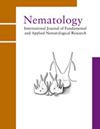覆盖作物对根结线虫种群密度的影响
IF 1.2
4区 生物学
Q2 ZOOLOGY
引用次数: 0
摘要
将吉木螺种群减少到经济损失阈值以下的管理策略在很大程度上取决于间作期间采取的措施。因此,本研究评价了chitwoodi在不同覆盖作物品种上的繁殖潜力。在盆栽试验条件下,对22个不同品种在低、高初始接种密度条件下对赤木霉的抗性进行了评价。休耕作为对照。根据繁殖因子将覆盖作物分为非寄主、不良寄主、维持寄主、良好寄主和优良寄主5类。在本研究中,在低初始接种密度(10个第二阶段幼体(J2) 100 cm−3土壤)和高初始接种密度(100 J2 100 cm−3土壤)条件下,根据繁殖因子(RF)值,在盆栽试验中,饲料萝卜‘Maximus’、‘Contra’、‘Dacapo’和‘Defender’、意大利黑麦草‘Meroa’、黑麦‘Matador’和鸟脚三叶草‘Barguay’、‘Franco’和‘Lotar’被认为是降低chitwoodi种群的不良寄主。田间试验证实了盆栽试验的大部分结果。然而,田间试验表明,覆盖作物的轮作受天气条件、前茬作物、生长期和初始种群密度的影响。根据我们的研究结果,可以推荐经选择的非寄主和差寄主覆盖作物用于chitwoodi的综合管理。本文章由计算机程序翻译,如有差异,请以英文原文为准。
Impact of cover crops on population density of the root-knot nematode Meloidogyne chitwoodi
Management strategies applied to reduce Meloidogyne chitwoodi populations below economic damage threshold depend strongly on measures taken during the intercrop period. Therefore, this study evaluated the reproductive potentials of M. chitwoodi on different cultivars of cover crops. Twenty-two different cultivars were evaluated against M. chitwoodi at low and high initial inoculum density in a pot experiment under controlled conditions. Fallow was used as control. Based on the reproductive factor, the cover crops were classified under five different categories: Non-host, Poor host, Maintenance host, Good host and Excellent host. In this study, at both low (10 second-stage juveniles (J2) 100 cm−3 soil) and high (100 J2 100 cm−3 soil) initial inoculum density of M. chitwoodi, fodder radish ‘Maximus’, ‘Contra’, ‘Dacapo’ and ‘Defender’, Italian ryegrass ‘Meroa’, rye ‘Matador’ and bird’s foot trefoil ‘Barguay’, ‘Franco’ and ‘Lotar’ were considered poor hosts reducing the M. chitwoodi population in the pot test based on reproductive factor (RF) values. Field experiments were carried out that confirmed most of our results in the pot experiments. However, the field experiments showed that the rotations in which the cover crops are implemented are influenced by weather conditions, previous crop grown, their growing period and initial population densities. Based on our findings, selected non- and poor-host cover crops could be recommended for integrated management of M. chitwoodi.
求助全文
通过发布文献求助,成功后即可免费获取论文全文。
去求助
来源期刊

Nematology
生物-动物学
CiteScore
2.60
自引率
33.30%
发文量
67
审稿时长
3 months
期刊介绍:
Nematology is an international journal for the publication of all aspects of nematological research (with the exception of vertebrate parasitology), from molecular biology to field studies. Papers on nematode parasites of arthropods, and on soil free-living nematodes, and on interactions of these and other organisms, are particularly welcome. Research on fresh water and marine nematodes is also considered when the observations are of more general interest.
Nematology publishes full research papers, short communications, Forum articles (which permit an author to express a view on current or fundamental subjects), perspectives on nematology, and reviews of books and other media.
 求助内容:
求助内容: 应助结果提醒方式:
应助结果提醒方式:


